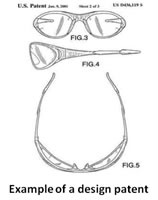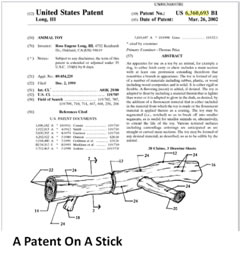 “Good Lord Boyet, my beauty, though but mean,
“Good Lord Boyet, my beauty, though but mean,
Needs not the painted flourish of your praise:
Beauty is bought by judgment of the eye,
Not uttered by base sale of chapmen's tongues”
William Shakespeare, British Playwright, from Love's Labour’s Lost, 1598
Intellectual Property (IP) is an ugly thing at a startup. It requires you to expend your two most valuable resources, your time and your money. Yet, it does nothing to help you execute your business model.
However, to a Big Dumb Company (BDC), a startup’s IP is a thing of beauty. Although BDCs often act irrationally, in this instance, their perception of beauty is highly rational.
If you haven't already subscribed yet, subscribe now for
free weekly Infochachkie articles!
 How can IP be worthless to a startup yet very worthwhile to a BDC? Because IP has intrinsic value, but only in the right hands.
How can IP be worthless to a startup yet very worthwhile to a BDC? Because IP has intrinsic value, but only in the right hands.
Patents held by startups generally have a limited ability to reduce competition. The average time required to obtain a patent is 36-to-40 months, during which there is no guarantee your adVenture will ultimately receive patent protection. Even if you are granted a patent, the scope of your claims may be significantly denuded.
Three years is a lifetime at a startup. Given that the average lifespan from startup to exit is five to seven years, the first half of a startup’s life is lived without explicit patent protection. Thus, if a startup team asks, “What is this patent worth to us?”, the answer is likely, “Not much.”
However, this is the wrong question. A more appropriate question is, “What is this patent worth to a BDC?” When answering this question, consider the following:
Wherewithal To Defend and Prosecute – IP litigation is immensely expensive. Most startups do not have the financial means to either defend the veracity of their IP or prosecute potential infringements by others. According to a 2003 survey conducted by the American Intellectual Property Lawyers Association, the average cost of patent litigation was $2 million, while trademark litigation averaged $600,000.
BDCs Are Risk Adverse – In general, BDCs are often more concerned with loss aversion than with pursuing potential gains. As such, they are hesitant to acquire a company which has not sought formal protection of their IP for two reasons. One is obvious, without protection, such IP might prove to be of little worth, as other companies can mimic the technology without recourse.
The second reason is more subtle. The very nature of formal IP approval process ensures that some level of vetting has been performed to assess whether the IP is infringing on another company’s technology. Although patents can, and are, granted which explicitly infringe on the rights of others, there is some comfort in the knowledge that a particular piece of IP has been approved for a patent or registered as a trademark. Even though such official sanction by the PTO does not guarantee that the protected IP does not infringe another party’s IP, it does provide a convenient excuse by which BDC executives can cover their butts, thereby reducing their perceived downside risk.
Complimentary And Derivative IP – In many instances, the IP created by a startup is a subset of a larger solution. It is often a feature or set of features which enhances the overall efficacy and value of a more comprehensive technology. As such, formally protected IP can have significant value in the hands of a BDC which may own or otherwise have access to complimentary IP.
In addition, a BDC may have developed derivative IP that on a standalone basis infringes on the startup’s IP. In such instances, acquiring the startup may be the shortest path to unmitigated IP ownership. This was the case when Intuitive Surgical purchased Computer Motion. This acquisition resolved the surgical robotic IP landscape and allowed Intuitive to dominate the market.
Even if your company is not acquired and you elect to access the public capital markets via an IPO, the above tenets remain valid. Once the IPO proceeds are in your bank account, your adVenture will have the ability to leverage and defend your IP and thus its intrinsic value will increase, just as it would in the hands of a BDC.
Not All Patent Types Are Created Equal
Another factor that impacts a patent’s value is its type, of which there are essentially two: utility patents and design patents. Note that I am ignoring other, far less common patent types, such as plant patents.
Utility patents represent 90% of all patents granted. They remain in effect twenty years following the filing date and, according to the Patent and Trademark Office (PTO), they protect: “the invention of a new and useful process, machine, manufacture, or composition of matter, or a new and useful improvement thereof.”
Utility patents generally offer more protection than design patents and are thus usually more valuable. They also often take longer to secure and are more expensive to obtain and prosecute.
An emerging subset of utility patents is business method patents. Such patents were especially popular when the Internet spawned new ways to solve old problems during the late 1990’s and the first decade of the 21st century. However, in most cases, the courts have not upheld business method patents and thus startups should not expend resources pursuing such broad and pervasive patents.
 Design patents make up the majority of non-utility patents. They remain in effect fourteen years from the filing date. Per the PTO, such patents protect: “A new, original, and ornamental design for an article of manufacture.”
Design patents make up the majority of non-utility patents. They remain in effect fourteen years from the filing date. Per the PTO, such patents protect: “A new, original, and ornamental design for an article of manufacture.”
An example of design patent is shown at left. It would not be difficult to emulate the design of these sunglasses without violating the patent. As such, the protection afforded design patents is generally limited and difficult to defend. However, they are usually easier and less costly to obtain, as compared to utility patents.
As seen in the patent at left, you can obtain a patent on virtually anything. PTO examiners consider a very narrow set of criteria which does not include the commercial efficacy of an idea.
Thus, the answer to the question “Can we get a patent on that is generally “Yes”, assuming the invention is remotely novel. However, a more appropriate question is “Should we get a patent on that?”
Return To Sender, IP Unknown
There is a common misconception that an idea can be protected by documenting it, placing it in an envelope and then mailing it to yourself. Underlying this presumption is the belief that if the envelop is unopened, the postmark will “prove” the date the idea was conceived (or at least when it was documented).
 Although such a letter might make an interesting plot point in a movie, in the real world, it provides you with absolutely no protection of your idea. Unlike an unregistered copyright, which you gain automatically by expressing an idea in written form, you cannot gain intellectual property protection by simply being the first person to describe an idea in writing.
Although such a letter might make an interesting plot point in a movie, in the real world, it provides you with absolutely no protection of your idea. Unlike an unregistered copyright, which you gain automatically by expressing an idea in written form, you cannot gain intellectual property protection by simply being the first person to describe an idea in writing.
For instance, if you document a novel, commercially viable idea and never file a patent to protect it, the only thing you will own is an unregistered and worthless copyright on the text describing the idea. However, anyone and everyone is free to exploit your idea and to even obtain a patent on it, if they are the first to file for such protection.
Provisional Approach
Most US high-tech companies begin the utility patent process by filing a provisional patent application. The PTO allows one year to elapse after filing a provisional application before you must submit a formal patent application. This approach makes sense for the following reasons:
- You gain a year to write a thoughtful, defensible patent without delaying your filing date. The filing date is often the deciding arbiter in IP disputes
- It is relatively inexpensive, thereby minimizing your sunk costs if you later decide to not pursue a formal patent filing
- You can describe your technology as “patent pending”, which may or may not be worthwhile, depending on your product and target customers
- Your solution will likely evolve as you gain market feedback and validation. As such, the additional time will help ensure that your patent claims accurately reflect the technology underlying your solution.
Know Thou Prior Art
As noted in Roping In The Legal Eagles, you have the responsibility to write the layman’s description of your patent claims. In order to do this effectively, you must understand the prior art germane to your application. Patentcafe defines Prior Art as: “the total body of knowledge, which teaches or otherwise relates directly to an invention. This is the primary criteria in determining the patentability of a new invention.” If you do not fully understand the prior art associated with your intellectual property, your patent request may be denied.
Just as you should anoint someone within your adVenture to be Watson and monitor your competitors’ activities, you should also explicitly assign someone to manage your adVenture’s IP portfolio. If you leave this to a committee, you risk your IP becoming a priority which no one person has adequate time to address.
It Ain’t The Number Of Patents, It’s The Number Of Defensible Claims That Matter
Some companies take pride in the number of patents they own. However, there is no direct correlation between a patent portfolio’s value and the number of patents which comprise the portfolio. A single patent with a number of comprehensive yet defensible claims can easily be worth far more than a legion of vague and narrowly defined patents. As such, focus on creating a manageable number of patents, each with multiple clear and defensible claims.
Patent examiners generally ask for clarification during the review process. The multiple claim approach provides you with greater flexibility to augment your claims when you address the PTO examiner’s objections and questions. Any accepted changes are subsumed within the original filing date of your provisional patent. This is especially important when your patent addresses an emerging technology that significantly changes during the course of the typical, multi-year review.
No Patents, No Interest
In addition to witnessing BDCs overvalue patents, I have also been a party to transactions in which the lack of formal IP protection caused BDCs to shy away from a potential acquisition. In one instance, I was on the Board of a small software company that declined to file any patents as the Founders felt they could not afford to take the time required to craft a meaningful application. This proved tragically shortsighted, as the company developed valuable augmentations to various open source technologies that likely qualified for patent protection.
After an extensive period, we eventually sold the company. However, the acquirer was a relatively small company that essentially purchased our install base of customers so they could sell them additional products. We received almost no value for our technology, even though it was effective and held in high regard by our customers. Little explicit value was affixed to it, because we did not have formal protection over it.
Mind Thine Eye of The BDC
As Shakespeare aptly notes, the beauty of a startup’s IP is bought by the judgment of the BDC’s eye. As such, when managing your IP portfolio, base your decisions on the understanding that the ultimate value of your IP will be determined by an acquisitive BDC or the public capital markets, not its worth in the hands of a capital-challenged startup.
Legal Caveat: I am NOT a lawyer. This advice is from a layman and it may be inappropriate and/or in conflict with the local laws of your county/state/province/country, etc. You should always seek local, qualified, legal counsel when addressing intellectual property issues.
______________________
John Greathouse has held a number of senior executive positions with successful startups during the past fifteen years, spearheading transactions which generated more than $350 million of shareholder value, including an IPO and a multi-hundred-million-dollar acquisition.
John is a CPA and holds an M.B.A. from the Wharton School. He is a member of the University of California at Santa Barbara’s Faculty where he teaches several entrepreneurial courses.
______________________
<
Copyright © 2007-10 by J. Meredith Publishing. All rights reserved.




Pingback: Ten Rookie Startup Mistakes You Won’t Make
Pingback: Quora
Pingback: IP as an exit strategy « Startups and IP Strategy
Pingback: IP as an exit strategy – ipstrategy.net
Pingback: IP as an exit strategy - Startups and IP Strategy
Pingback: 8 Fundraising Deal Breakers Inexperienced Entrepreneurs Routinely Create